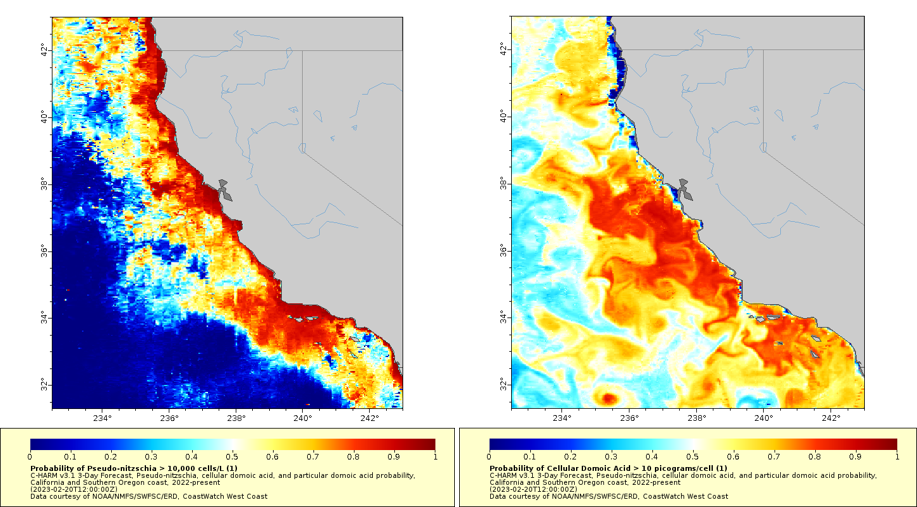| Date |
March 14, 2023
|
|---|---|
| Content Type |
User Story
|

|
|
| Data Applications |
Ecosystem Monitoring
Fisheries & Aquaculture
Transportation & Safety
Water Quality
|
The West Coast Node (WCN) of CoastWatch is home to thousands of datasets; from ACSPO SST to Vector Winds, their ERDDAP server stores decades of historic climate data. But one group of products stands out with its impact on the coastal communities of California and Southern Oregon: C-HARM.
What is C-HARM?
The California-Harmful Algae Risk Mapping (C-HARM) Harmful Algal Bloom (HAB) products predict the occurrences of harmful species of Pseudo-nitzschia and the toxin they produce, domoic acid, using sophisticated circulation models, satellite remote-sensing data, and statistical models. More information regarding the methodology can be found in Anderson et al. 2016. Note that the current version of C-HARM, v3, integrates the West Coast Operational Forecast System (WCOFS).
In layman's terms, C-HARM products are forecasts of toxin levels and Pseudo-nitzschia in coastal waters, developed by applying data from ocean physics models and ocean color satellites to algae probability models. The resulting information can be mapped to create images as shown below, which represent the probability of high levels of Pseudo-nitzchia (left) and cellular domoic acid (right) on February 23, 2023, as predicted three days in advance. Products are also available as one- and two-day forecasts, and as a Nowcast.

What are Pseudo-nitzschia and Domoic Acid?
Pseudo-nitzschia is a common genus of microscopic marine algae, or phytoplankton, of which some species produce a neurotoxin, domoic acid. When these phytoplankton “bloom,” or grow to a population of 10,000 cells per liter of seawater, the resident shellfish are likely to consume Pseudo-nitzschia, and with it, domoic acid.
There are two common measurements for domoic acid (DA): particulate DA and cellular DA. Particulate DA models, or Domoic Acid Event Prediction, predict the concentration of DA in the bloom. The bloom is considered a HAB when there are at least 500 nanograms of domoic acid per liter of affected water. Toxicity is still possible at a lower concentration, but this threshold has been established through multiple studies. C-HARM products predict the percent probability of the bloom reaching this threshold. Cellular DA models, or Domoic Acid Toxicity Prediction, are a forecast measurement for the amount of DA per individual cell of Pseudo-nitzschia (a single-cellular algae as shown above). The threshold for a toxic cell is 10 picograms of domoic acid per cell, which has been established through the same research as the particulate DA threshold. C-HARM products predict the percent probability of the Pseudo-nitzschia containing 10 picograms.
Is Domoic Acid bad?
Domoic acid can build up in shellfish that consume Pseudo-nitzschia without visibly harming them. However, people and animals that eat the toxin-containing shellfish can develop serious illnesses resulting from Amnesic Shellfish Poisoning (ASP). Symptoms can appear as early as 15 minutes after eating shellfish, or even 40 hours later. The most common reactions are typical of food poisoning: vomiting, diarrhea, abdominal pain, etc. that can last several days. Severe cases may result in permanent short-term memory loss, hence the term “Amnesic” Shellfish Poisoning. There is no antidote for domoic acid; treatment is largely limited to hydration maintenance and pain management.
How can consumers avoid Amnesic Shellfish Poisoning?
It is impossible to determine whether a specimen is contaminated without laboratory testing, and domoic acid cannot be eliminated once it has been absorbed into tissue. Cooking or freezing shellfish before eating will not prevent toxication. Therefore, for consumers to continue enjoying California’s coastal critters, it is necessary to avoid shellfish that have been exposed to Pseudo-nitzschia.
How does C-HARM help?
Pseudo-nitzschia blooms and the neurotoxin they produce can be accurately predicted days in advance using forecast models paired with satellite data. C-HARM does just that; by avoiding areas deemed unsafe by C-HARM, consumers are far less likely to contract ASP. Note: Even if shellfish are from a low-risk area, the likelihood of poisoning is never zero.
Domoic acid has become the top issue for the U.S. West Coast. One particularly severe event began in mid-August 2022 in Ventura, and spread along the coast of Southern California over a few weeks. Over 400 sea lions and seals were found stranded with apparent poisoning. C-HARM was used daily to track the bloom and alert necessary response teams, such as the West Coast Marine Mammal Stranding Network. While the report has yet to be published, Clarissa Anderson - Director of the Southern California Coastal Ocean Observing System (SCCOOS) and lead developer of C-HARM - says officials studying the impact of this bloom measured the highest ever DA levels in animal tissue.
The frequency of impact events has only grown in the past 25 years. The ability to accurately predict toxic blooms is crucial for local fisheries, aquaculture, and marine mammal rescue groups to mitigate harm and more effectively manage coastal resources. In its first five years of availability, C-HARM has become a daily necessity for several key sectors.
C-HARM products are available through the CoastWatch West Coast Node ERDDAP, found here.
